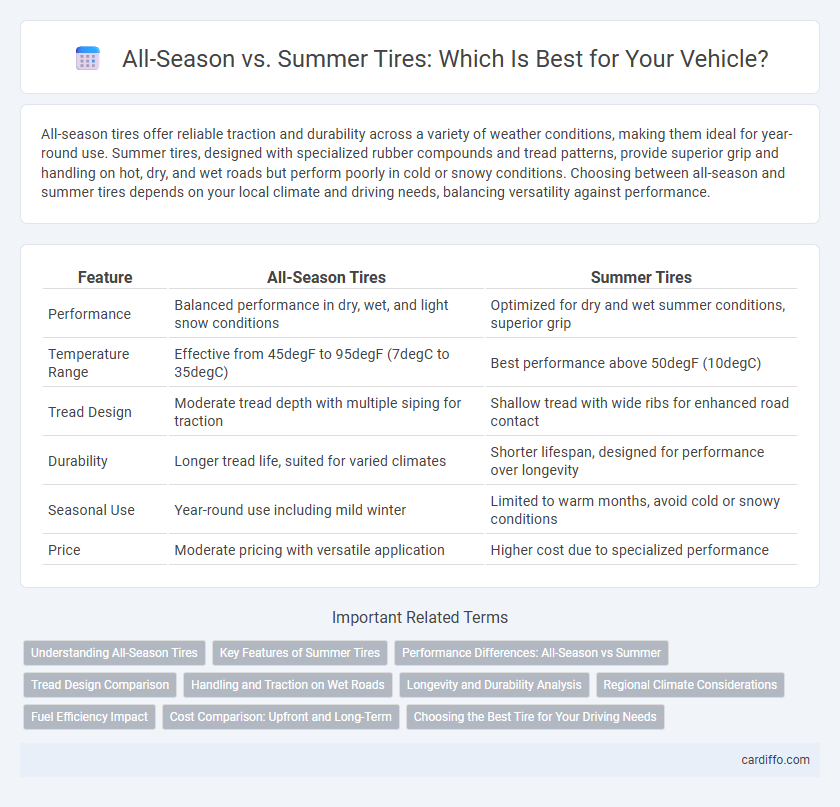All-season tires offer reliable traction and durability across a variety of weather conditions, making them ideal for year-round use. Summer tires, designed with specialized rubber compounds and tread patterns, provide superior grip and handling on hot, dry, and wet roads but perform poorly in cold or snowy conditions. Choosing between all-season and summer tires depends on your local climate and driving needs, balancing versatility against performance.
Table of Comparison
| Feature | All-Season Tires | Summer Tires |
|---|---|---|
| Performance | Balanced performance in dry, wet, and light snow conditions | Optimized for dry and wet summer conditions, superior grip |
| Temperature Range | Effective from 45degF to 95degF (7degC to 35degC) | Best performance above 50degF (10degC) |
| Tread Design | Moderate tread depth with multiple siping for traction | Shallow tread with wide ribs for enhanced road contact |
| Durability | Longer tread life, suited for varied climates | Shorter lifespan, designed for performance over longevity |
| Seasonal Use | Year-round use including mild winter | Limited to warm months, avoid cold or snowy conditions |
| Price | Moderate pricing with versatile application | Higher cost due to specialized performance |
Understanding All-Season Tires
All-season tires offer a balanced performance suitable for moderate weather conditions including light snow, featuring a tread design that combines durability and traction in wet and dry conditions. They utilize a rubber compound optimized to remain flexible across a wider temperature range compared to summer tires, which are engineered primarily for warm weather with enhanced grip and handling on dry and wet roads but lack winter traction. Understanding the limitations of all-season tires in extreme winter or high-performance summer environments is essential for selecting the right tire based on specific driving needs and climate conditions.
Key Features of Summer Tires
Summer tires offer superior traction on wet and dry roads thanks to their specialized tread patterns and rubber compounds designed for warm conditions. Their stiffer sidewalls enhance cornering performance and steering precision, making them ideal for high-speed driving and sporty handling. These tires also exhibit shorter braking distances and improved responsiveness compared to all-season tires, optimizing safety and control during hot weather.
Performance Differences: All-Season vs Summer
All-season tires provide moderate traction across various weather conditions, including light snow, wet, and dry surfaces, but they generally offer less grip and handling precision compared to summer tires. Summer tires are engineered with specialized rubber compounds and tread patterns that maximize dry and wet performance, delivering superior cornering, braking, and responsiveness in warm temperatures. Performance-focused drivers prefer summer tires for their enhanced traction and shorter stopping distances on dry and wet roads, while all-season tires prioritize versatility and longer tread life.
Tread Design Comparison
All-season tires feature a moderate tread pattern with multiple sipes and grooves, optimizing water evacuation and enhancing traction on wet or light snow conditions. Summer tires have a more aggressive tread design with larger, solid tread blocks and fewer grooves to maximize road contact and improve dry handling and cornering performance. The difference in tread depth and pattern directly influences noise levels, wear rates, and seasonal performance capabilities.
Handling and Traction on Wet Roads
All-season tires provide reliable traction on wet roads by combining tread patterns and rubber compounds designed for diverse weather conditions, but they may sacrifice some handling precision compared to summer tires. Summer tires feature specialized rubber compounds and tread designs that maximize grip and responsiveness on wet pavement, delivering superior handling performance in warm, rainy conditions. For drivers prioritizing sharp cornering and braking on wet roads during warmer months, summer tires offer enhanced traction and control over all-season options.
Longevity and Durability Analysis
All-season tires typically offer enhanced longevity and durability due to their rubber compounds designed to withstand a wider range of temperatures and road conditions. Summer tires, while optimized for maximum performance and grip in warm weather, generally feature softer rubber that wears faster, especially on rough or abrasive surfaces. The tread design of all-season tires promotes even wear, extending tire life compared to summer tires, which prioritize traction over durability.
Regional Climate Considerations
All-season tires provide reliable traction in moderate climates with occasional rain or light snow, making them ideal for regions with mild winters and variable temperatures. Summer tires deliver superior grip and performance on dry and wet roads in warm climates, but their rubber compounds harden and lose effectiveness in cold weather, posing risks in regions prone to frost or snow. Choosing the right tire depends on local climate patterns, road conditions, and temperature fluctuations to maximize safety and tire longevity.
Fuel Efficiency Impact
All-season tires generally offer lower rolling resistance than summer tires, which can lead to improved fuel efficiency in moderate driving conditions. Summer tires provide enhanced grip and performance on warm, dry roads but often increase fuel consumption due to higher rolling resistance. Selecting the appropriate tire type based on seasonal driving conditions directly influences fuel economy and overall vehicle efficiency.
Cost Comparison: Upfront and Long-Term
All-season tires generally have a lower upfront cost compared to summer tires but may wear out faster in extreme heat, leading to more frequent replacements and higher long-term expenses. Summer tires, while pricier initially, offer superior durability and performance, reducing replacement frequency and potential maintenance costs over time. Evaluating total cost of ownership involves balancing initial investment against longevity and performance requirements for specific driving conditions.
Choosing the Best Tire for Your Driving Needs
All-season tires provide balanced performance in wet, dry, and light winter conditions, making them ideal for drivers in moderate climates seeking versatility and year-round convenience. Summer tires offer superior grip and handling on warm, dry, or wet roads, enhancing performance and safety during hot weather but lacking traction in cold or snowy conditions. Selecting the best tire depends on your local climate, typical driving conditions, and performance priorities to ensure optimal safety and longevity.
All-Season vs Summer Infographic

 cardiffo.com
cardiffo.com